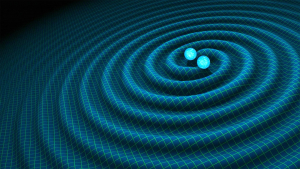REDONGRA, a network to boost Spain’s role in gravitational wave astronomy, counts on IFIC’s collaboration
The Spanish Network for Gravitational Wave Physics (REDONGRA), led by Carlos Fernández Sopuerta, researcher at the Institute of Space Sciences (ICE-CSIC), includes the Institute of Corpuscular Physics (IFIC, a joint center of CSIC and the University of Valencia) as one of its members. REDONGRA has been awarded funding under the 2024 Research Networks call from the Spanish Ministry of Science, Innovation and Universities. This financial support highlights the strategic importance of REDONGRA in consolidating and expanding Spain’s leadership in gravitational wave science.
REDONGRA has two main objectives: to coordinate and maximise Spain’s contribution to gravitational wave astronomy, and to prepare the next generation of scientists and infrastructure for future flagship missions such as LISA and the Einstein Telescope. The network will develop a roadmap for Spain’s strategic participation in these missions to advance our understanding of the universe through the detection and analysis of gravitational waves.
The network brings together 20 top-level research groups from across Spain, including institutions already actively involved in major international collaborations such as LIGO, Virgo, the Einstein Telescope, LISA, and Pulsar Timing Arrays (PTAs). ICE-CSIC, as one of the central pillars of the network, plays a crucial role both scientifically and institutionally. Its Gravitational Astronomy-LISA research group, led by Carlos F. Sopuerta, Miquel Nofrarias, and Sascha Husa, spearheaded Spain’s contributions to ESA’s LISA Pathfinder mission (completed in 2018) and is currently leading the development of instrumentation, data analysis, and ground segment activities for the future LISA mission.
The LISA (Laser Interferometer Space Antenna) mission will be the first space-based gravitational wave observatory. Adopted by ESA in 2024, its launch is scheduled for 2035. It will consist of a constellation of three spacecraft separated by 2.5 million km (more than six times the Earth-Moon distance) in a triangular formation orbiting the Sun. This configuration will allow LISA to scan the entire sky following Earth’s orbit, detecting both polarizations of gravitational waves simultaneously.
“REDONGRA is a unique opportunity for Spain’s growing gravitational wave astronomy community. It will boost our participation in current and future international collaborations (LVK, ET, LISA, etc.),” said Carlos F. Sopuerta, researcher at ICE-CSIC and the Institute of Space Studies of Catalonia (IEEC).
The network’s activities began in May 2025, and several events are already scheduled for the rest of the year. First, from June 23 to 25, the Iberian Gravitational Wave Meeting took place, bringing together all network members to review progress, share the latest research developments, and plan collaborative projects for the coming year. Other upcoming events include the 10th anniversary of the first gravitational wave detection, on September 15–16 at the University of the Balearic Islands (UIB) in Mallorca; the second LISA Spain Meeting, on October 23–24 at CSIC headquarters in Madrid; and the 10th anniversary of the LISA Pathfinder launch, on December 3 at ICE-CSIC in Barcelona. In the future, the network will also organise a school on gravitational wave physics, offering a comprehensive training programme for graduate students entering the field.
This new phase in REDONGRA’s development marks a significant expansion over its previous iterations and places Spain at the centre of a rapidly evolving international landscape. By aligning top-tier research institutions under a shared vision and investing in training and outreach, REDONGRA aims to establish gravitational wave science not only as a cutting-edge field, but also as a national strength.
IFIC's contribution to REDONGRA
The Institute of Corpuscular Physics (IFIC, CSIC/UV) participates in REDONGRA through researchers such as Daniel Figueroa, who represents IFIC in the international Einstein Telescope (ET) collaboration, and Agustín Sánchez Losa, coordinator of the REDONGRA node at IFIC and member of the VEGA group. Daniel Figueroa's research focuses on calculating the spectral shape of gravitational wave backgrounds generated in the early universe — whether from cosmic inflation or from hypothetical sources like phase transitions, topological defects such as cosmic strings, or non-perturbative particle production. IFIC leads lattice (non-linear) calculations of these signals, with precise spectral shape determination being crucial for identifying physics beyond the Standard Model if such signals are detected in the future.
Meanwhile, Agustín and several members of VEGA work on real-time searches for possible counterparts to gravitational waves detected by the LIGO-VIRGO-KAGRA interferometers, using the KM3NeT neutrino telescope. Alert follow-up is essential for multi-messenger astronomy. In 2017, the simultaneous detection of gravitational waves and a gamma-ray burst confirmed the first observed neutron star merger and its kilonova. That same year, the detection of a high-energy neutrino from a blazar in a flaring state provided the first evidence for a cosmic neutrino source.
“The simultaneous detection of a gravitational wave and a neutrino emission would be a historic milestone in multi-messenger astronomy, giving us a global view of the source and the astrophysical mechanisms at play.”
REDONGRA member institutions:
Institute of Space Sciences (ICE-CSIC), Centre for Energy, Environmental and Technological Research (CIEMAT), Institute of Astrophysics of Andalusia (IAA-CSIC), Institute of Astrophysics of the Canary Islands (IAC), Institute of Cosmos Sciences of the University of Barcelona (ICCUB), Institute of Structure of Matter (IEM-CSIC), Institute for High Energy Physics (IFAE), Institute of Physics of Cantabria (IFCA-CSIC/UC), Institute of Corpuscular Physics (IFIC-CSIC/UV), Institute for Theoretical Physics (IFT-CSIC/UAM), Galician Institute of High Energy Physics (IGFAE), University of Alicante (UA), University of Cádiz (UCA), University of Granada (UGR), University of the Balearic Islands (UIB), Polytechnic University of Catalonia - BarcelonaTech (UPC), Polytechnic University of Madrid (UPM), University of the Basque Country (UPV/EHU), University of Salamanca (USAL), and University of Valencia (UV).
More information: REDONGRA website




















